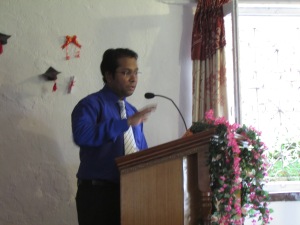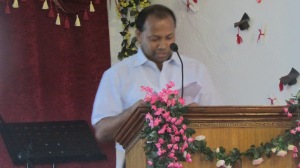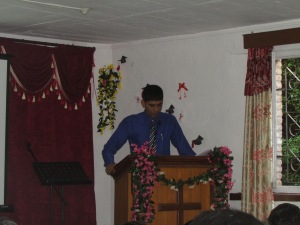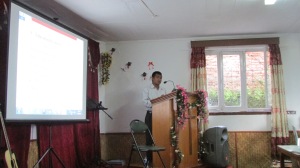Nepali Christian Theology Academic Forum: The Outcome
I. Introduction
This blog will outline the outcome of the Nepali Christian Theology Academic Forum (NCTAF) held on 12th September 2014 at Nepal Ebenezer Bible College (NEBC). The participants who attended the forum are NEBC students, alumni, faculty from NEBC and other Bible colleges. The forum was opened with an introduction by Rev. Ram Kumar Budhathoki (Principal, NEBC).
II. The Questions Raised Prior to the Forum:
The questions that were raised before the form are as follows– How do we contextualize Gospel in Nepali context? Is there a way? Is there any methodology to contextualize? What are the dangers involved in contextualization of the gospel? What is the role of the church, missions and theological academia in contextualizing the gospel? What is Nepal Christian theology? Will this help the church to communicate the gospel to the pluralistic society of Nepal in a more winsome manner? What are the roles of a believer, teacher, and a pastor in contextualizing the Gospel? Is there any set paradigm/s to contextualize the Gospel? These questions were subsequently addressed by the presenters in their respective papers.
III. Review of the papers:
A. Towards A ‘Nepal’ Christian Theology: A Proposal – Yeshwanth B. V, Academic dean, NEBC
The article mainly focuses on the methodology. The author addressed the questions like how do we contextualize the Gospel without losing its Christian essence? He proposed “contextualization: A biblically-based method.” This method is primarily based on a ‘grammatico-historical’ exegetical method coupled with a social analysis. Besides this, he also proposes the sources of doing NCT. He outlines very briefly the sources as Scripture, tradition, reason and experience while Scripture plays an authoritative and primary source which regulates other sources. He also defines NCT as “a systematic, contextual articulation of Christian faith in the pluralistic society of Nepal that explains Christian faith to the church (didactic), proclaims the same to the larger society (kerygma), and defends the same against the objections from non-Christians (apologia). He also remarks that NCT should not be overtly provincial but also universal.
B. Reading John’s Gospel in Nepali Context- Dr. Johnson Thomaskutty, Faculty in NT dept, UBS, Pune
This article mainly focuses on the interpretative framework for the gospel in a globalized Nepali context. The author tried to explore the ‘gnomic significance’ of John’s gospel–by which the message intended for the Johannine community can be applied to the Nepali community. In order to do this, he proposed the interpretative framework of John’s gospel to address the contemporary realities of Nepal, to synthesis speech-action between mission and evangelism, and to fill the gaps between Johannine community of first century AD and Nepali communities of twenty-first century AD. With this mind, the author elucidates John’s gospel–by which he brings out some affinities between John’s context and Nepali context in terms of discipleship, persecution, mission, the role of women, speech-action paradigm for mission from ‘I AM’ sayings of Jesus, rhetoric signs, importance of ‘Paracletos‘ in missions, dialogical approach in church ministry, the characters in John’s gospel which has close affinity with people and circumstances in Nepali context, the individual, public and private aspects of ministry, and ‘Newness’ in our approaches, and lastly our concern towards dalits (marginalized people). Basing on this, author proposes Johannine mission model for a “dynamic Nepalization” for the present context of Nepal.
C. Theological Development in Nepali Context: A Historical Perspective – Rev. Ram Kumar Budhathoki, Principal, NEBC
The article outlines the historical development of contextualization that contributed towards theological maturity in Nepali context. The author very vividly outlines the above as follows. Firstly, Catholic mission (before 1950’s), during which theological development was basically characterized as social reform and contextualization was in a very primitive stage. Secondly, emergence of indigenous church movements (1950-1960), during which the theological development can be characterized with the ‘cultural sensitivity’ that was recognized and contextualization was not given much attention and the church faced persecution during this time. Thirdly, period of persecution (1960-1990), during this period theological development was rapid and maturing and contextualization was seriously considered though not fully realized. Fourthly, the present scenario (1990- ), with the surge of church growth and theological institution as democracy was established in Nepal, theological development is at its peak and this period has been witnessing the actualization of contextualization.
With this outline in mind, the author makes some suggestions regarding the future of the theological development. Firstly, he suggests that the curricula in theological colleges needs to revised and relevant to the Nepali context. Secondly, a partnership was suggested among the theological institutions to publish a theological journal for Nepali church. Thirdly, forums on regular basis to be conducted. Fourthly, envisioning a center for research. Fifthly, developing faculty to teach higher degrees in theology. Finally, the author recommends the church and theological institutions to join hands in contextualizing the gospel in Nepali context.
D. Nepali Christian Theology: A Missiological Perspective – Ps. Norbu Tamang, Visiting faculty, NBC
The article focuses on the role of missions in reaching Nepalese in Nepal and beyond. The author proposes a ‘contextualized’ methods in missions in Nepali context. Firstly, he clarifies the terminology — mission/s. Secondly, he outlines different contextual methods in our missions. They are namely intercession, sending, going, and planting and nurturing churches. Thirdly, he briefly explains the role of missions in contextualizing the gospel in Nepal. Fourthly, he bring our five contextual methods in missions namely top-bottom approach–in which the opinion makers and leaders are reached out first; tent-making approach–in which a missionary can contribute through his/her professional expertise besides evangelism; welcome approach–in which non-Nepalese in Nepal are welcomed and reached out; people group approach–in which particular communities were considered and reached out with gospel; Scriptural motivation for missionary work.
E. Nepali Christian Theology: A Shared Task of Ecclesia and Academia – Ps. David Rai, Visiting faculty, NEBC
The article focuses on the ‘shared’ task of the Nepali church and theological institutions in contextualizing the gospel in Nepal. The author lays the socio-cultral contexts of the theological educational system in Nepal. Subsequently he describes the role of the church in theological education in terms of educating the congregation and realizing its vital role in society, and partnering with bible colleges and institutions for theological education. He also describes the role of theological colleges in theological education in terms of educating and shaping theologians for the churches. Keeping this in mind, the author presents the positive and negative sides of the ‘shared’ task. The positive aspect is the increased interest in the theological education among the pastors and leader and hence they send the students the bible colleges. The negative aspect is the disappointment expressed by many pastors over the theological graduates for creating splits in the church. Then the author makes some suggestions for a relevant theological education that should be shared between the church and theological institution. He recommends a ‘partnership, mutual-dependance, and mutual-respect’ between the church and theological colleges. Only the contextualization can rightly actualized and perpetuated in Nepal.
IV. The outcome: Responses
The closing discussion was moderated by Dr. Johnson Thomaskutty. He presented the following questions. They are (1) How do you understand the aspects of contextualization of gospel in Nepal? (2) How do we continue this forum (future of NCTAF)? (3) How Bible can be placed in the process of contextualization? (4) How are you going to apply the insights drawn from the forum in your life, ministry, and theological engagements? (5) Is there a need for Nepali curriculum and journal?
Most of the respondents recognized the primacy of the Scriptures in the process of contextualization. Nevertheless, the risks of contextualization has also been recognized. In this pretext, some respondents expressed the need for a translation of the Bible into Nepali that is relevant and comprehensible to the Nepali readers and terminological clarifications in Nepali translations. Besides these, many expressed the need for such forums for the development of Nepali theological academic on par with global theological academia. The host institution, i.e., NEBC strongly felt the need to a theological journal to further the task of contextualization in Nepal.






Leave a comment